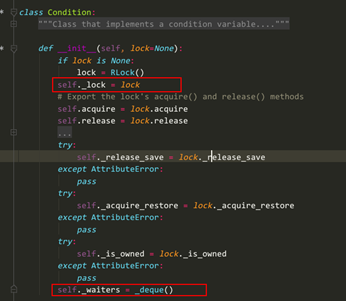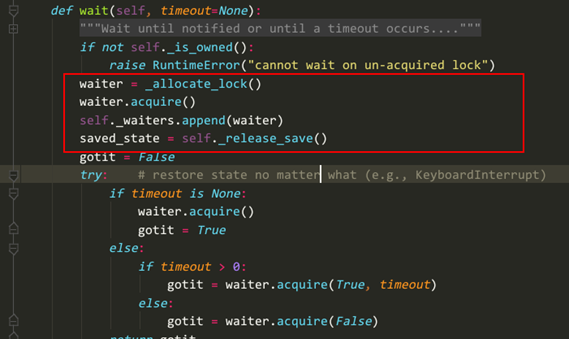gj11 多线程、多进程和线程池编程
11.1 python中的GIL
# coding=utf-8
# gil global interpreter lock (cpython)
# python中一个线程对应于c语言中的一个线程
# gil使得同一个时刻只有一个线程在一个cpu上执行字节码, 无法将多个线程映射到多个cpu上执行 # gil会根据执行的字节码行数以及时间片释放gil,
# gil在遇到io的操作时候主动释放 import dis
def add(a):
a = a + 1
return a print(dis.dis(add))
total = 0 def add():
# 1. dosomething1
# 2. io操作
# 1. dosomething3
global total
for i in range(1000000):
total += 1 def desc():
global total
for i in range(1000000):
total -= 1 import threading thread1 = threading.Thread(target=add)
thread2 = threading.Thread(target=desc)
thread1.start()
thread2.start() thread1.join()
thread2.join()
print(total) # 在IO频繁的时候是很适合的
执行多少行后字节码会释放
11.2 python多线程编程
操作系统最小的执行单元
# coding=utf-8
# __auther__ = 'lewen' import time
import threading def get_detail_html(url):
print("get detail html started")
time.sleep(2)
print("get detail html end") def get_detail_url(url):
print("get detail url started")
time.sleep(4)
print("get detail url end") if __name__ == "__main__":
# 在主线程起两个线程
thread1 = threading.Thread(target=get_detail_html, args=("",))
thread2 = threading.Thread(target=get_detail_url, args=("",))
# thread1.setDaemon(True)
# thread2.setDaemon(True) # 守护线程,当主线程退出的时候, 子线程kill掉 start_time = time.time()
thread1.start()
thread2.start() thread1.join() # 等待线程的执行完成,才会执行下面
thread2.join() print("last time: {}".format(time.time() - start_time))
通过集成Thread来实现多线程
class GetDetailHtml(threading.Thread):
def __init__(self, name):
# py2 必须在括号写类名
# 继承父类的name
super().__init__(name=name) def run(self):
print("get detail html started")
time.sleep(2)
print("get detail html end") class GetDetailUrl(threading.Thread):
def __init__(self, name):
super().__init__(name=name) def run(self):
print("get detail url started")
time.sleep(4)
print("get detail url end")
if __name__ == "__main__":
thread1 = GetDetailHtml("get_detail_html")
thread2 = GetDetailUrl("get_detail_url")
start_time = time.time()
thread1.start()
thread2.start() thread1.join()
thread2.join() print("last time: {}".format(time.time() - start_time))
11.3 线程间通信-Queue
共用变量
# 线程间通信 import time
import threading
from chapter11 import variables from threading import Condition detail_url_list = [] # 1. 生产者当生产10个url以后就就等待,保证detail_url_list中最多只有十个url
# 2. 当url_list为空的时候,消费者就暂停 def get_detail_html(lock):
# 爬取文章详情页
detail_url_list = variables.detail_url_list # 将共享变量存放到文件中去
while True: if len(variables.detail_url_list):
if len(detail_url_list):
url = detail_url_list.pop()
# for url in detail_url_list:
print("get detail html started")
time.sleep(2)
print("get detail html end")
else:
time.sleep(1) def get_detail_url(lock):
# 爬取文章列表页
detail_url_list = variables.detail_url_list
while True:
print("get detail url started")
time.sleep(4)
for i in range(20):
if len(detail_url_list) >= 10:
time.sleep(1)
else:
detail_url_list.append("http://projectsedu.com/{id}".format(id=i))
print("get detail url end") # 1. 线程通信方式- 共享变量 if __name__ == "__main__":
thread_detail_url = threading.Thread(target=get_detail_url, args=(lock,))
for i in range(10):
html_thread = threading.Thread(target=get_detail_html, args=(lock,))
html_thread.start()
# # thread2 = GetDetailUrl("get_detail_url")
start_time = time.time() # 当主线程退出的时候, 子线程kill掉
print("last time: {}".format(time.time() - start_time))
# 通过共用变量
from queue import Queue import time
import threading def get_detail_html(queue):
# 爬取文章详情页
while True: url = queue.get() # 阻塞,没有会停在这
print(url)
# 内部基于deque
print("get detail html started")
time.sleep(1)
print("get detail html end") def get_detail_url(queue):
# 爬取文章列表页
while True:
print("get detail url started")
time.sleep(2)
for i in range(9):
queue.put("http://www.baidu.com/s?wd=".format(id=i))
print(queue.qsize())
print("get detail url end") # 1. 线程通信方式- 共享变量 if __name__ == "__main__":
detail_url_queue = Queue(maxsize=1000) thread_detail_url = threading.Thread(target=get_detail_url, args=(detail_url_queue,)) html_thread_list = []
for i in range(10):
html_thread = threading.Thread(target=get_detail_html, args=(detail_url_queue,))
html_thread.start()
html_thread_list.append(html_thread)
start_time = time.time() for h in html_thread_list:
h.join()
# detail_url_queue.join() # 这里想退出,必须等到 detail_url_queue.task_done()调用,才会退出 print("last time: {}".format(time.time() - start_time))
# 通过queue的方式进行线程间同步
11.4 线程同步(Lock、RLock、Semaphores、Condition)
from threading import Lock, RLock, Condition # 可重入的锁 # Lock 不能重复调用
total = 0
lock = RLock() # 在同一个线程里面,可以连续调用多次acquire, 一定要注意acquire的次数要和release的次数相等
# 多个线程之间仍会竞争 def add(): global lock
global total
for i in range(1000000):
lock.acquire()
lock.acquire() # 一个线程里面重入的锁
total += 1
lock.release()
lock.release() def desc():
global total
global lock
for i in range(1000000):
lock.acquire()
total -= 1
lock.release() import threading thread1 = threading.Thread(target=add)
thread2 = threading.Thread(target=desc)
thread1.start()
thread2.start() thread1.join()
thread2.join()
print(total) # 1. 用锁会影响性能
# 2. 锁会引起死锁
# 死锁的情况 A(a,b)
"""
A(a、b)
acquire (a)
acquire (b) # 阻塞住,死在这 B(b、a)
acquire (b) # 交互死锁,资源竞争
acquire (a)
"""
Lock、RLock
condition 使用以及源码分析
import threading class XiaoAi(threading.Thread):
def __init__(self, lock):
super().__init__(name="小爱")
self.lock = lock def run(self):
self.lock.acquire()
print("{} : 在 ".format(self.name))
self.lock.release() self.lock.acquire()
print("{} : 好啊 ".format(self.name))
self.lock.release() class TianMao(threading.Thread):
def __init__(self, lock):
super().__init__(name="天猫精灵")
self.lock = lock def run(self): self.lock.acquire()
print("{} : 小爱同学 ".format(self.name))
self.lock.release() self.lock.acquire()
print("{} : 我们来对古诗吧 ".format(self.name))
self.lock.release()
if __name__ == "__main__": lock = threading.Lock() xiaoai = XiaoAi(lock)
tianmao = TianMao(lock) tianmao.start()
xiaoai.start() # ---
天猫精灵 : 小爱同学
天猫精灵 : 我们来对古诗吧
小爱 : 在
小爱 : 好啊
没有使用condition
class XiaoAi(threading.Thread):
def __init__(self, cond):
super().__init__(name="小爱")
self.cond = cond def run(self):
with self.cond:#第一把锁
self.cond.wait()
print("{} : 在 ".format(self.name))
self.cond.notify() self.cond.wait()
print("{} : 好啊 ".format(self.name))
self.cond.notify() self.cond.wait()
print("{} : 君住长江尾 ".format(self.name))
self.cond.notify() self.cond.wait()
print("{} : 共饮长江水 ".format(self.name))
self.cond.notify() self.cond.wait()
print("{} : 此恨何时已 ".format(self.name))
self.cond.notify() self.cond.wait()
print("{} : 定不负相思意 ".format(self.name))
self.cond.notify() class TianMao(threading.Thread):
def __init__(self, cond):
super().__init__(name="天猫精灵")
self.cond = cond def run(self):
with self.cond: #第一把锁
print("{} : 小爱同学 ".format(self.name))
self.cond.notify() # 提醒
self.cond.wait() # 等待条件提醒 print("{} : 我们来对古诗吧 ".format(self.name))
self.cond.notify()
self.cond.wait() print("{} : 我住长江头 ".format(self.name))
self.cond.notify()
self.cond.wait() print("{} : 日日思君不见君 ".format(self.name))
self.cond.notify()
self.cond.wait() print("{} : 此水几时休 ".format(self.name))
self.cond.notify()
self.cond.wait() print("{} : 只愿君心似我心 ".format(self.name))
self.cond.notify()
self.cond.wait()
if __name__ == "__main__": cond = threading.Condition()
xiaoai = XiaoAi(cond)
tianmao = TianMao(cond) # 在调用with cond之后才能调用wait或者notify方法
# condition有两层锁, 一把底层锁(with condition)会在线程调用了wait方法的时候释放,
# 上面的锁会在每次调用wait的时候分配一把并放入到cond的等待队列中,等到notify方法的唤醒
xiaoai.start()
tianmao.start() # 启动顺序很重要
# 天猫start 后 notify ,然后小爱 start 进入wait ,一直接受不到 notify 就阻塞住
# start 后 wait 的线程应该先启动去等着,以免接受不到notify # ---
天猫精灵 : 小爱同学
小爱 : 在
天猫精灵 : 我们来对古诗吧
小爱 : 好啊
天猫精灵 : 我住长江头
小爱 : 君住长江尾
天猫精灵 : 日日思君不见君
小爱 : 共饮长江水
天猫精灵 : 此水几时休
小爱 : 此恨何时已
天猫精灵 : 只愿君心似我心
小爱 : 定不负相思意

在调用with cond之后才能调用wait或者notify方法
condition有两层锁, 一把底层锁(with condition)会在线程调用了wait方法的时候释放,
上面的锁会在每次调用wait的时候分配一把并放入到cond的等待队列中,等到notify方法的唤醒


Semaphore 使用
# Semaphore 是用于控制进入数量的锁
# 文件, 读、写, 写一般只是用于一个线程写,读可以允许有多个 # 做爬虫
import threading
import time class HtmlSpider(threading.Thread):
def __init__(self, url, sem):
super().__init__()
self.url = url
self.sem = sem def run(self):
time.sleep(2)
print("got html text success")
self.sem.release() class UrlProducer(threading.Thread):
def __init__(self, sem):
super().__init__()
self.sem = sem def run(self):
for i in range(20):
self.sem.acquire()
html_thread = HtmlSpider("https://baidu.com/{}".format(i), self.sem)
html_thread.start() if __name__ == "__main__":
sem = threading.Semaphore(3)
url_producer = UrlProducer(sem)
url_producer.start()
11.5 concurrent线程池编码
# 线程池, 为什么要线程池
# 主线程中可以获取某一个线程的状态或者某一个任务的状态,以及返回值
# 当一个线程完成的时候我们主线程能立即知道
# futures可以让多线程和多进程编码接口一致 from concurrent.futures import ThreadPoolExecutor, as_completed, wait, FIRST_COMPLETED
import time def get_html(times):
time.sleep(times)
print("get page {} success".format(times))
return times
executor = ThreadPoolExecutor(max_workers=2) # 通过submit函数提交执行的函数到线程池中, submit 是立即返回
task1 = executor.submit(get_html, (3))
task2 = executor.submit(get_html, (2)) # done方法用于判定某个任务是否完成
print(task1.done()) # print(task2.cancel()) # 取消任务(成功返回True),在执行中或开始执行的时候是不能取消的
# time.sleep(3)
# print(task1.done()) # result 是阻塞的方法可以获取task的执行结果
print(task1.result()) # --------- urls = [3,2,4]
all_task = [executor.submit(get_html, (url)) for url in urls] # 批量提交 wait(all_task, return_when=FIRST_COMPLETED)
print("main") # 要获取已经成功的task的返回
# for future in as_completed(all_task):
# data = future.result()
# print("get {} page".format(data)) # 通过executor的map获取已经完成的task的值
# for data in executor.map(get_html, urls):
# print("get {} page".format(data)) # 跟提交值顺序相同 # ----
False
get page 2 success
get page 3 success
3
get page 2 success
main
get page 3 success
get page 4 success
from concurrent.futures import Future
#未来对象,task的返回容器
11.6 多进程编程-multiprocessing
# 多进程编程
# 耗cpu的操作,用多进程编程, 对于io操作来说, 使用多线程编程,进程切换代价要高于线程 # 1. 对于耗费cpu的操作,多进程由于多线程 import time
from concurrent.futures import ThreadPoolExecutor, as_completed
from concurrent.futures import ProcessPoolExecutor def fib(n):
if n<=2:
return 1
return fib(n-1)+fib(n-2) if __name__ == "__main__":
with ProcessPoolExecutor(3) as executor: #last time is: 14.505059242248535
# with ThreadPoolExecutor(3) as executor: # last time is: 30.066641330718994
all_task = [executor.submit(fib, (num)) for num in range(25,40)]
start_time = time.time()
for future in as_completed(all_task):
data = future.result()
print("exe result: {}".format(data)) print("last time is: {}".format(time.time()-start_time))
#2. 对于io操作来说,多线程优于多进程
def random_sleep(n):
time.sleep(n)
return n if __name__ == "__main__":
# with ThreadPoolExecutor(3) as executor:
with ProcessPoolExecutor(3) as executor:
all_task = [executor.submit(random_sleep, (num)) for num in [1]*30]
start_time = time.time()
for future in as_completed(all_task):
data = future.result()
print("exe result: {}".format(data)) print("last time is: {}".format(time.time()-start_time))
import os
import time
# fork只能用Linux/unix中
pid = os.fork()
print("lewen",pid) if pid ==0: #子进程拷贝
print("子进程 %s,父进程 %s"%(os.getpid(),os.getppid()))
else:
print("我是父进程:%s"%(pid)) time.sleep(2) [root@doit ~]# python fork_test.py
('lewen', 16077)
我是父进程:16077
('lewen', 0)
子进程 16077,父进程 16076 import os
import time
# fork只能用Linux/unix中
print("lewen",pid) pid = os.fork() if pid ==0: #子进程拷贝
print("子进程 %s,父进程 %s"%(os.getpid(),os.getppid()))
else:
print("我是父进程:%s"%(pid)) time.sleep(2) [root@doit ~]# python fork_test.py
lewen
我是父进程:16096
子进程 16096,父进程 16095
os.fork()
from concurrent.futures import ProcessPoolExecutor # 进程池,基于multiprocessing,推荐
import multiprocessing # 多进程编程
import time def get_html(n):
time.sleep(n)
print("sub_progress success")
return n class MyProcess(multiprocessing.Process):
def run(self):
pass if __name__ == "__main__":
# progress = multiprocessing.Process(target=get_html, args=(2,))
# print(progress.pid)
# progress.start()
# print(progress.pid)
# progress.join()
# print("main progress end") """
None
10796
sub_progress success
main progress end """ # 使用线程池
pool = multiprocessing.Pool(multiprocessing.cpu_count())
# result = pool.apply_async(get_html, args=(3,)) # 异步提交任务
#
# # 等待所有任务完成
# pool.close() # 关闭,不再接受新的任务进来,才不会出错
# pool.join()
#
# print(result.get())
"""
sub_progress success
3
""" # imap
# for result in pool.imap(get_html, [1, 5, 3]):
# print("{} sleep success".format(result))
"""
sub_progress success
1 sleep success
sub_progress success
sub_progress success
5 sleep success
3 sleep success
""" for result in pool.imap_unordered(get_html, [1, 5, 3]): # 谁先完成就打出来
print("{} sleep success".format(result)) """
sub_progress success
1 sleep success
sub_progress success
3 sleep success
sub_progress success
5 sleep success """
11.7 进程间通信
# 共享全局变量通信
# 共享全局变量不能适用于多进程编程,可以适用于多线程 def producer(a):
a += 100
time.sleep(2) def consumer(a):
time.sleep(2)
print(a) if __name__ == "__main__":
a = 1
my_producer = Process(target=producer, args=(a,))
my_consumer = Process(target=consumer, args=(a,))
my_producer.start()
my_consumer.start()
my_producer.join()
my_consumer.join()
---
1
共享全局变量不能适用于多进程编程,可以适用于多线程
# multiprocessing中的queue不能用于pool进程池
# pool中的进程间通信需要使用manager中的queue
import time
from multiprocessing import Process, Queue, Pool, Manager, Pipe def producer(queue):
queue.put("a")
time.sleep(2) def consumer(queue):
time.sleep(2)
data = queue.get()
print(data) if __name__ == "__main__":
queue = Manager().Queue(10)
pool = Pool(2) pool.apply_async(producer, args=(queue,))
pool.apply_async(consumer, args=(queue,)) pool.close()
pool.join() --
a
2 pool中的进程间通信需要使用manager中的queue
#通过pipe(管道)实现进程间通信
#pipe的性能高于queue def producer(pipe):
pipe.send("lewen") def consumer(pipe):
print(pipe.recv()) if __name__ == "__main__":
recevie_pipe, send_pipe = Pipe()
# pipe只能适用于两个进程
my_producer= Process(target=producer, args=(send_pipe, ))
my_consumer = Process(target=consumer, args=(recevie_pipe,)) my_producer.start()
my_consumer.start()
my_producer.join()
my_consumer.join()
3 通过pipe(管道)实现进程间通信
内存共享
def add_data(p_dict, key, value):
p_dict[key] = value if __name__ == "__main__":
progress_dict = Manager().dict()
from queue import PriorityQueue # 优先级队列,后插入的数据尽快被获取到 first_progress = Process(target=add_data, args=(progress_dict, "lewen1", 22))
second_progress = Process(target=add_data, args=(progress_dict, "lewen2", 23)) first_progress.start()
second_progress.start()
first_progress.join()
second_progress.join() print(progress_dict) ---
{'lewen1': 22, 'lewen2': 23}
gj11 多线程、多进程和线程池编程的更多相关文章
- 第十章:Python高级编程-多线程、多进程和线程池编程
第十章:Python高级编程-多线程.多进程和线程池编程 Python3高级核心技术97讲 笔记 目录 第十章:Python高级编程-多线程.多进程和线程池编程 10.1 Python中的GIL 10 ...
- Python进阶:多线程、多进程和线程池编程/协程和异步io/asyncio并发编程
gil: gil使得同一个时刻只有一个线程在一个CPU上执行字节码,无法将多个线程映射到多个CPU上执行 gil会根据执行的字节码行数以及时间片释放gil,gil在遇到io的操作时候主动释放 thre ...
- linux C 多线程/线程池编程 同步实例
在多线程.线程池编程中经常会遇到同步的问题. 1.创建线程 函数原型:int pthread_create(pthread_t *thread, const pthread_attr_t *attr, ...
- Java多线程系列--“JUC线程池”06之 Callable和Future
概要 本章介绍线程池中的Callable和Future.Callable 和 Future 简介示例和源码分析(基于JDK1.7.0_40) 转载请注明出处:http://www.cnblogs.co ...
- Java多线程系列--“JUC线程池”02之 线程池原理(一)
概要 在上一章"Java多线程系列--“JUC线程池”01之 线程池架构"中,我们了解了线程池的架构.线程池的实现类是ThreadPoolExecutor类.本章,我们通过分析Th ...
- Java多线程系列--“JUC线程池”03之 线程池原理(二)
概要 在前面一章"Java多线程系列--“JUC线程池”02之 线程池原理(一)"中介绍了线程池的数据结构,本章会通过分析线程池的源码,对线程池进行说明.内容包括:线程池示例参考代 ...
- Java多线程系列--“JUC线程池”04之 线程池原理(三)
转载请注明出处:http://www.cnblogs.com/skywang12345/p/3509960.html 本章介绍线程池的生命周期.在"Java多线程系列--“基础篇”01之 基 ...
- Java多线程系列--“JUC线程池”05之 线程池原理(四)
概要 本章介绍线程池的拒绝策略.内容包括:拒绝策略介绍拒绝策略对比和示例 转载请注明出处:http://www.cnblogs.com/skywang12345/p/3512947.html 拒绝策略 ...
- 转:java多线程CountDownLatch及线程池ThreadPoolExecutor/ExecutorService使用示例
java多线程CountDownLatch及线程池ThreadPoolExecutor/ExecutorService使用示例 1.CountDownLatch:一个同步工具类,它允许一个或多个线程一 ...
随机推荐
- OpenCV版本下载
https://sourceforge.net/projects/opencvlibrary/files/opencv-win/
- 前端-HTML练习题
本小节重点: 熟练使用div+span布局,知道div和span的语义化的意思 熟悉对div.ul.li.span.a.img.table.form.input标签有深刻的认知,初期也了解他们,知道他 ...
- kafka 修改partition,删除topic,查询offset
修改分区个数: ./kafka-topics./kafka/<id_of_kafka> --alter --partitions 10 --topic test_topic 上面命令将te ...
- redis 查询key数量
info查询所有库的key数量 dbsize查询当前库的key数量 keys * 查询当前库的所有key,数量少的时候可以用,当key很多的时候很慢,be careful!
- request.getParameterMap()获得Map中的数据
今天使用request.getParameterMap()获得Map中的数据时,使用 Map map=request.getParameterMap(); i ...
- Technology, globalisation and the squeeze on good jobs
Technology, globalisation and the squeeze on good jobs技术与全球化冲击好工作“Highest stock market EVER! Jobs ar ...
- (1)shiro简介和第一个demo
之前一直在用shiro开发,不过只是会使用,并没有深入了解,最近有时间学习了一下,把最近学习所得分享一下. shiro简介 Apache Shiro是一个强大且易用的Java安全框架,执行身份验证.授 ...
- jsp+Servlet+JavaBean+JDBC+MySQL项目增删改查
1简单的Mvc,分层建包. java resources src/mian/java (1)dao 包 JDBC连接类,连接数据库.增删改查方法,其他的方法. (2)model包 实体类,数据库字段, ...
- winform程序开机启动时的运行目录
并不是程序的当前路径,而是系统的某个目录 如环境是win10 64位,路径是 c:\winfows\SysWOW64\ConfigInfor.json
- hdoj2859(矩阵DP)
题目链接:http://acm.hdu.edu.cn/showproblem.php?pid=2859 思路: 第一次碰到这种矩阵上的DP题,想了半天也没想明白.本来想用子矩阵的左上角坐标和右下角坐标 ...
